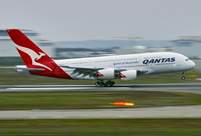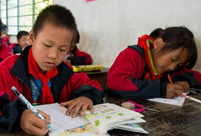 'Model husband' shatters image of love
'Model husband' shatters image of love
 Can animals smile? Or put on a happy face
Can animals smile? Or put on a happy face
 Geng Xuan crowned at 9th China Super Model Contest
Geng Xuan crowned at 9th China Super Model Contest
 Top 10 billionaires in the liquor industry
Top 10 billionaires in the liquor industry
 Backstage at China Fashion Week
Backstage at China Fashion Week
 Ballerinas anywhere but onstage
Ballerinas anywhere but onstage
 Top 10 safest airlines in the world
Top 10 safest airlines in the world
 Posters of 33rd HK Film Awards unveiled
Posters of 33rd HK Film Awards unveiled
 Top 10 most popular instant messaging apps in the world
Top 10 most popular instant messaging apps in the world
 Inspiring shadow images of Chinese army
Inspiring shadow images of Chinese army
BEIJING, April 13 -- Shanghai residents will soon receive more accurate air quality reports with the launch of a new calculating system.
Air Quality Index (AQI) calculations will be partly based on an hourly figure for PM2.5 — tiny particles especially harmful as they can get deep into the respiratory system — instead of a 24-hour average PM2.5 figure used at present.
Already approved by central government, the new system will be introduced very soon, Zhang Quan, director of Shanghai Environmental Protection Bureau, said yesterday.
Currently, the AQI, which is reported hourly, is calculated based on levels of six pollutants: PM2.5, PM10, sulfur dioxide, nitrogen dioxide, ozone and carbon monoxide.
While readings for four of these are presently updated hourly, PM2.5 and PM10 figures are an average for the previous 24 hours, in line with national standards.
Zhang also said Shanghai will need approval from central government if it intends to introduce an Air Quality Health Index (AQHI), already in use in Hong Kong.
AQHI provides health advice and alerts for groups particularly sensitive to air pollution — such as the very young, the elderly and those with respiratory problems — depending on levels of pollutants.
“Shanghai’s AQI system gives advice to people to reduce short-term exposure to air pollution through adjusting activities but AQHI is more detailed,” Zhang said.
In another air pollution initiative, a joint air quality alert center covering Shanghai and neighboring provinces Zhejiang, Jiangsu and Anhui is to be located in the city.
Joint alerts are intended to ensure that the Yangtze River Delta can take quick, coordinated action to tackle air pollution.
“The meteorological and environment departments of Shanghai and the three provinces are working together closely on the air pollution joint alert system,” said Zhang.
A coordinated effort to fight pollution across the Yangtze River Delta was launched in January, and also includes a unified standard for energy conservation and emission cuts to be achieved.
“Our main concerns include the use of resources, coal consumption restrictions, straw burning and emissions from vehicles and ships,” said Zhang.
He said in Shanghai 500 to 600 polluting industrial enterprises are made to clean up their act or closed each year, and some neighbors are having to play catch up to achieve uniform standards.
“Jiangsu Province might have to take action on more than 1,000 polluting enterprises every year to catch up with the pace of the joint effort in the Yangtze River Delta region,” said Zhang. “These are historical problems from earlier developments.”
Meanwhile, the city is to continue increasing punishments for polluting air, water and soil through illegal discharges and emissions.
Shanghai has already adjusted its penalty system, levying fines on a daily basis to encourage immediate improvements.
Fines totaling 70 million yuan (US$11.27 million) were collected by the environment bureau in 2013 — up 50 percent on 2012.
Now the bureau is also turning its attention to individuals in companies responsible for pollution.
“In future, punishments will also be handed out to individuals, with them receiving fines and shouldering legal responsibilities,” said Zhang.
He also said more water quality detection stations will be built at the borders of the city to neighboring provinces.
The bureau director added that the city government has approved building another reservoir, similar to the Qingcaosha Reservoir in the mouth of Yangtze River.
Currently, most of Shanghai’s tap water comes from Qingcaosha Reservoir and the Huangpu River. Monitoring water quality is easier in closed reservoirs.
 Wonderful moment of China's airborne forces
Wonderful moment of China's airborne forces Bai Baihe shoots for fashion magazine
Bai Baihe shoots for fashion magazine Red terraced fields in Dongchuan of Yunnan
Red terraced fields in Dongchuan of Yunnan Jiaju Tibetan Village
Jiaju Tibetan Village Spring dating
Spring dating Confucius institute at UC Davis
Confucius institute at UC Davis Little painted faces at temple fair
Little painted faces at temple fair Top 10 safest airlines in the world
Top 10 safest airlines in the world Foreign students at China-Myanmar border
Foreign students at China-Myanmar border The backstage of the Fashion Week
The backstage of the Fashion Week College students in Han costumes
College students in Han costumes Postgraduate works as waitress
Postgraduate works as waitress Life in a Lahu village in Yunnan
Life in a Lahu village in Yunnan An orphan’s wedding
An orphan’s wedding Hollywood documentary brings Diaoyu Islands truth to new audience
Hollywood documentary brings Diaoyu Islands truth to new audienceDay|Week|Month